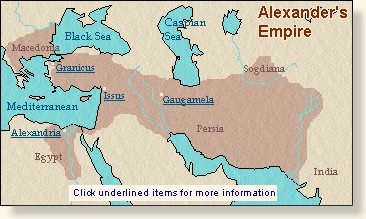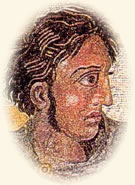|
Alexander Defeats
The Persians, 331 BC
Alexander began his war against the Persians in 334 BC. At the time the Macedonian leader was twenty-two years old. At his death eleven years later, Alexander ruled the largest empire of the ancient world. His victory at the battle of Gaugamela on the Persian plains was a decisive conquest that insured the defeat of his Persian rival King Darius III.
Darius was prepared for battle having selected this spot to meet his enemy.  After his defeat at Issus two years previously, Darius made sure that this battleground favored his army and its tactics - particularly the use of his feared scythe-wheeled chariots. The ground here was flat, perfect for chariots. Darius made it even flatter by ordering the terrain plowed and leveled. All was ready and on October 1, 331 BC the Persian army of possibly 200,000 (ancient texts exaggerate the number up to 1 million) faced off against Alexander's 35,000. The Macedonian leader immediately sized up the Persian's tactical advantage and countered by ordering his cavalry to shift to the right hoping to move his enemy away from its flat field. Darius took the bait ordering his troops to follow. Soon the Persians found themselves on rough, rock-strewn terrain. Seeing the thinning Persian line, Alexander led the charge that crashed through to the Persian rear. As at the battle of Issus, Darius fled, leaving the field and victory to Alexander. After his defeat at Issus two years previously, Darius made sure that this battleground favored his army and its tactics - particularly the use of his feared scythe-wheeled chariots. The ground here was flat, perfect for chariots. Darius made it even flatter by ordering the terrain plowed and leveled. All was ready and on October 1, 331 BC the Persian army of possibly 200,000 (ancient texts exaggerate the number up to 1 million) faced off against Alexander's 35,000. The Macedonian leader immediately sized up the Persian's tactical advantage and countered by ordering his cavalry to shift to the right hoping to move his enemy away from its flat field. Darius took the bait ordering his troops to follow. Soon the Persians found themselves on rough, rock-strewn terrain. Seeing the thinning Persian line, Alexander led the charge that crashed through to the Persian rear. As at the battle of Issus, Darius fled, leaving the field and victory to Alexander.
The following description of the battle of Gaugamela was written by the Greek historian Arrian in the second century AD. His account is based on contemporary sources and is considered well written and accurate:
"When the armies drew near each other, Darius and the men especially around him were observed opposite Alexander himself and his royal squadron of cavalry. Alexander led his own army more towards the right, and the Persians marched parallel along with him, far outflanking him upon their left. Then the Scythian cavalry rode along the line and came into conflict with the front men of Alexander's army; nevertheless he still continued to march towards the right, and almost entirely got beyond the ground that had been cleared and leveled by the Persians. Then Darius, fearing that his chariots would become useless if the Macedonians advanced upon the uneven ground, ordered the front ranks of his left wing to ride round the right wing of the Macedonians, where Alexander was commanding, to prevent him from marching his wing any further.
Darius unleashes
his scythed-wheeled
chariots
|
[Translator's note: This led to countermoves by Alexander and precipitated a general cavalry engagement; the Greeks suffered severely, but sustained the assaults, and] assailing the enemy violently squadron by squadron, succeeded in pushing them out of rank. Meanwhile the Barbarians launched the scythed-chariots against Alexander himself, to throw his phalanx into confusion; but in this they were grievously deceived. For as soon as they approached the [Macedonian] javelin men, who had been posted in front of the 'Companion' cavalry, hurled their darts at some of the horses; others they seized by the reins and pulled the drivers off, and standing round the horses killed them. Yet some got right through the ranks; for the men stood apart, and opened their ranks, as they had been taught, wherever the chariots attacked. Thus commonly the chariots went through safely, and their drivers were unhurt, but the [rear guard]
later overpowered them.
As soon as Darius set his whole battle line in motion, Alexander ordered Aretes to attack those who were riding clear around his right wing; and up to that time he was himself leading his men in column. But when the Persians made a break in the front line of their army, when their cavalry
 |
Alexander
from a mosaic on
a Pompeiian wall |
charged to aid those executing the flanking movement, Alexander wheeled towards the gap, and forming a wedge as it were of the 'Companion' cavalry and of the part of the phalanx which was posted here, he led them with a quick charge, and a loud battle cry straight towards Darius. Then came a short hand-to-hand melee; but when the Macedonian horse, led by Alexander himself, pressed on vigorously, thrusting themselves against the Persians and striking their faces with their spears, and when the Macedonian phalanx in dense array, bristling with long pikes, had joined in the attack, general terror smote Darius, whose courage already had been shaken; so that he was the first to turn and flee. Likewise the Persians who were trying to outflank, panic-stricken at the vigorous attack of Aretes, took to flight; and in this quarter the Macedonians chased after and slaughtered the fugitives.
[Elsewhere on the battlefield, however, the Persians pressed boldly; broke through the Macedonian line and began to plunder Alexander's camp; while others attacked Parmenio's division on the flank, putting it in great straits. At the news of Parmenio's peril] Alexander
turned back from the pursuit, and wheeling round with the 'Companion' cavalry
led them at full speed against the Barbarian's right wing. Here ensued the most
obstinately contested cavalry fight in the whole battle. For drawn up by squadrons,
the foreigners wheeled round in deep column, and falling on Alexander's men face
to face, no longer relied on javelin casting, or skillful deploying of horses,
as is usual in cavalry battles, but every man for himself strove desperately
to break through what stood in his way, as his only means of safety. Here about
60 of Alexander's 'Companions' fell were wounded. But these foes, too, Alexander
overcame; and such as could force their way through his ranks fled with all their
might.
Meantime the Thessalian cavalry in a splendid struggle were not falling short of Alexander's own success in the combat. For the Barbarians on the right wing were already beginning to fly when be came on the scene of [this] conflict; so that again he wheeled, and started in pursuit of Darius once more, keeping up the chase while daylight lasted. [After resting his men till midnight, Alexander pursued again all next day, but did not take the king, for] Darius went on fleeing without any rest. However, the money and all his other wealth were captured, likewise his chariot; and his spear and bow were also taken, as they had been after Issus.
Of Alexander's men about 100 were killed and more than 1000 of his horses; either from wounds or exhausted in the pursuit. . . Of the Barbarians there are said to have been 300,000 slain, and far more taken prisoners than were killed."
References:
Davis, William Stearns, Readings In Ancient History (1912); Fox, Robert Lane, Alexander The Great (1994).
How To Cite This Article:
"Alexander Defeats The Persians, 331 BC," EyeWitness to History, www.eyewitnesstohistory.com (2000).
|






